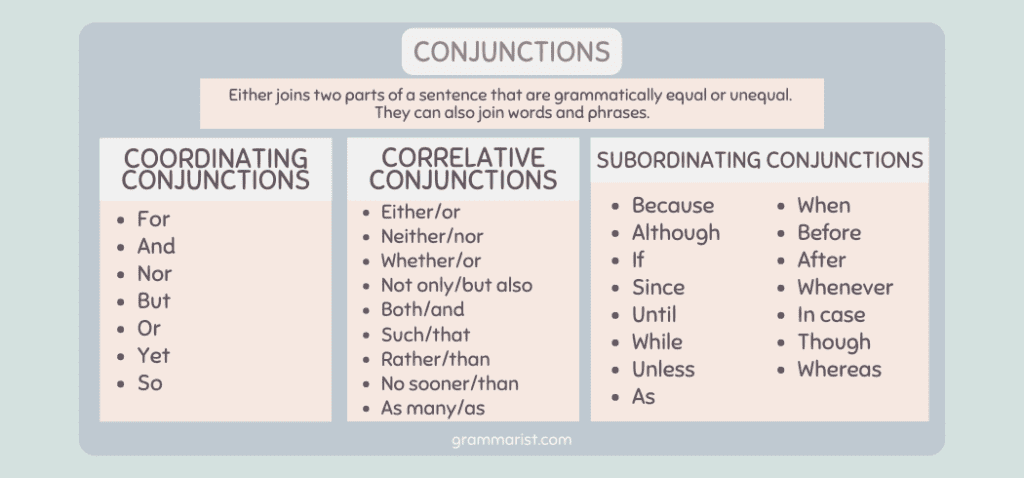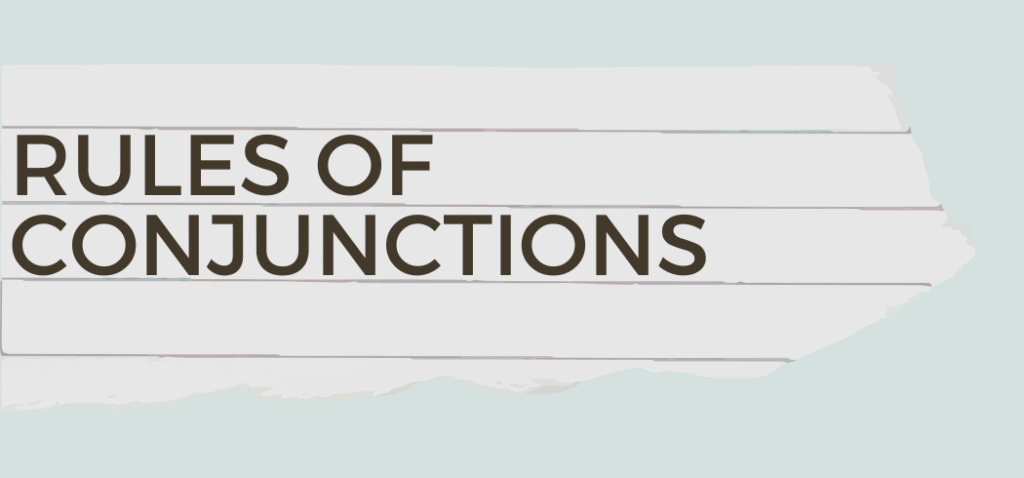Do you want to avoid writing repetitive and choppy sentences? Using conjunctions will improve your writing flow. I always argue with my editor about my use of conjunctions because she thinks I don’t use them enough. But I feel there’s a time and place for them in writing, and it’s all about stylistic choices.
Continue reading to understand the basics of conjunctions as I break them down for you. Explore its definitions, types, and when to use conjunctions properly in sentences. Without this part of speech, you won’t be able to produce elegant and complex sentences…no matter what an editor might say.
What Does a Conjunction Do?
Well, conjunctions’ definition in grammar is any word that connects a word, phrase, or clause in sentences. I know what you’re thinking; don’t all words connect to one another? Yes, but conjunctions are special. Some of the most common English conjunctions are and, or, but, because, if, when, and for.
A conjunction either joins two parts of a sentence that are grammatically equal or unequal. They can also join words and phrases.
What are the 3 Types of Conjunctions?
In the English language, three main types of conjunction show different relationships between elements. But it’s essential to understand the types of clauses first.
An independent clause is a bunch of words with a subject and predicate that can stand on its own as a sentence. A dependent clause are words with a subject and predicate that can’t stand on its own as a sentence.
Coordinating Conjunctions
A coordinating conjunction joins elements of equal grammatical value or rank. They can join two nouns, verbs, adjectives, independent clauses, and phrases. To remember the seven coordinating conjunctions, just memorize the acronym FANBOYS. That’s what I do!
- For.
- And.
- Nor.
- But.
- Or.
- Yet.
- So.
Note that so can be a coordinating conjunction and a subordinating conjunction. That means it can link two independent clauses or an independent clause with a dependent clause.
Correlative Conjunctions
Correlative conjunctions are pairs of conjunctions connecting phrases or words. We use them to make our flow of writing better and more concise. Below are the most common pairs of correlative conjunctions.
- Either/or.
- Neither/nor.
- Whether/or.
- Not only/but also.
- Both/and.
- Such/that.
- Rather/than.
- No sooner/than.
- As many/as.
Subordinating Conjunctions
A subordinating conjunction is one of the kinds of conjunctions that links a dependent or subordinate clause to an independent clause.
Business writers, academic writers, and other professional writers know that simple sentences can never start with a subordinating conjunction.
The most common subordinating conjunctions are:
- Because.
- Although.
- If.
- Since.
- Until.
- While.
- Unless.
- As.
- When.
- Before.
- After.
- Whenever.
- In case.
- Though.
- Whereas.
A noun clause is an example of a subordinate clause that acts as a noun. It also starts with subordinating conjunctions.
Conjunction Rules
All parts of speech include rules on correct usage. Here are some guidelines and conjunction examples.
Commas Before Conjunctions
Many style guides recommend using a comma before coordinating conjunctions like and, or, and but two join independent clauses. Here are some examples.
- She’s an excellent debater, but her tone of voice needs improvement.
- I would like to go swimming at the beach, or I could stay home and watch a movie.
But it’s okay to leave out the comma from a sentence if the following independent clause is short. For example:
- I had cake and Jenna had coffee.
Conjunctive Adverbs or Adverbial Conjunctions
A conjunctive adverb is a type of adverb that links independent clauses or shows a relationship between sentences.
It has a similar but not exact purpose as a coordinating conjunction. Correctly using them helps you attain parallelism in sentence structure. Here are some conjunctive adverbs.
- Also.
- Besides.
- However,
- Finally.
- Furthermore.
- Nonetheless.
- Still.
For example:
- I enjoyed the salmon sashimi. However, California maki is still my favorite.
Here, however functions as an adverb.
But in the example below, the adverb until functions as a conjunction.
- I’ll be out until you come home.
Punctuating Complex Sentences and Subordinate Conjunctions
A comma is required when the dependent clause comes before the independent clause. For example:
- Because I was absent, I missed the announcement.
Note that sentences beginning in participial phrases do not need subordinating conjunction. For example:
- Surprised by Joe’s arrival, Hailey dropped a spoon.
Prepositions and Conjunctions
Both prepositions and conjunctions link words within sentences. But a preposition is always followed by pronouns, nouns, or phrases to form prepositional phrases. Meanwhile, conjunctions are followed by any part of speech to form a clause.
Subject-Verb Agreement for Correlative Conjunctions
The element nearest to the verb indicates if the verb is singular or plural. For example:
- Neither the doctor nor the nurses know who the patient is.
- Either the nurses or the doctor administers the medicine.
Starting a Sentence With a Conjunction
It’s possible to produce a grammatically-correct sentence that starts with a conjunction, such as and and but. For example:
- Kryz enjoys living in the city. But she also dreams of living in the suburbs with her own family.
Separating these two independent clauses emphasizes the use of but.
Some readers dislike sentences starting with conjunctions because they seem melodramatic or informal. Consider your audience before producing your sentences.
Conjunctions in Sentences
Here’s a list of real-life examples of conjunctions in sentences.
- I like eating burritos, nachos, tacos, and chocolate.
- I enjoy drinking green tea latte. But I like espresso latte more.
- I went to Arizona because I wanted to visit my grandmother.
- Carl doesn’t want to throw away his toy collection, nor does he want to donate them to charity.
- Whereas nouns name persons, places, things, and events, adjectives modify nouns and pronouns.
- Robin took a nap after John came home.
- I drive the car whenever she’s away.
- Either Samantha or Shane will run for president of the student council.
- Jacob is not only offering a ride home but also asking me out for dinner.
Is And a Conjunction?
Yes. And is a type of coordinating conjunction. It connects all words, phrases, and clauses of equal importance.
Concluding Conjunctions
My guide hopefully has shown you the definition and types of conjunctions. I’ve also provided examples of how to use them in sentences.
Properly using conjunctions will help you write more elegant sentences and be a better writer. Without them, you’ll be forced to produce monotonous, simplistic sentences without showing a relationship between elements.


Comments are closed.